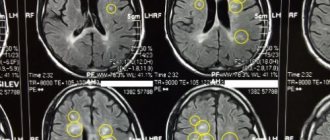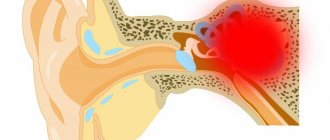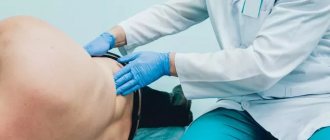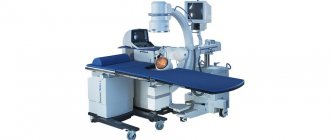NIMANNA-PIKA DISEASE
(A. Niemann, German pediatrician, 1880-1921; L. Pick, German pathologist, 1868-1935; synonym:
phosphatidic lipoidosis, lipoid cell spleiohepatomegaly, sphingomyelin lipoidosis, lipoid histiocytosis
) - a disease caused by a hereditary disorder lipid metabolism (sphingophospholipids), in which sphingomyelin accumulates in the liver, brain, spleen, adrenal glands, kidneys, lymph nodes, skin and mononuclear blood cells.
First described by Niemann in 1914; Peak in 1922 gave a wedge, and a cytol, a description of the disease, pointing out its differences from other lipidoses (see).
Etiology and pathogenesis
Niemann-Pick disease is a hereditary disease with an autosomal recessive mode of inheritance (see). The incidence of the disease in boys and girls is the same.
Pathogenesis N.—P. b. is associated with a deficiency in tissues of sphingomyelinase, an acidic lysosomal hydrolase that carries out the hydrolytic cleavage of sphingomyelin (see). With sphingomyelinase deficiency, the normal catabolism of sphingomyelin is disrupted and it accumulates in tissues. Possibility of excessive synthesis of sphingomyelin in N.—P. b. It has not been experimentally confirmed, but has not yet been completely ruled out. The content of sphingomyelin in patients in the cortex and white matter of the brain can increase 1.5-2 times compared to the norm. An increase in the content of this lipid is also found in the cerebrospinal fluid.
When should you see a doctor?
The first visit to the doctor should be at the moment when the couple is planning to have a child, if there are relatives in the family with Niemann-Pick genetic pathology.
It is also necessary to consult a geneticist if the child has signs of sphingomyelinosis pathology:
- The child is developmentally delayed;
- The child has insufficient appetite, or its complete absence;
- The baby is not gaining enough body weight.
Pathological anatomy
An autopsy reveals a sharp increase in the size of the liver, spleen, and lymph. nodes, adrenal glands with their tissue stained yellow. Sometimes there is depigmentation or yellowish-brown discoloration of the skin.
Microscopic specimen of a lymph node in Niemann-Pick disease: Pick cells are indicated by arrows; Azan staining according to Heidenhain; x 400.
Histologically, large (diameter 30-60 microns), oval-shaped macrophages are detected in the tissues of internal organs - the so-called. Pick cells. They contain from one to four nuclei, their cytoplasm is foamy due to the accumulation of small drops of sphingomnelin (Fig.). Pick cells stain well with Sudan III, osmium, nil lau sulfate and other dyes and give a positive Smith-Dietrich reaction, staining black and blue. Large numbers of Pick cells are found in the liver; they are represented by stellate reticuloendotheliocytes (Kouifer cells), increased in size, their cytoplasm is filled with drops of fat. In the lymph spleen, follicles are not identified, its pulp is diffusely infiltrated with Pick cells, hemorrhages, zones of necrosis at various stages of organization, and areas of scarring are found. In the adrenal glands, accumulations of Pick cells are found. arr. in the medulla. In the nights, Pick cells are rare; fatty degeneration is expressed in the nephrothelium.
Sphingomyelin is deposited in neurons and glial cells of the brain, especially in the cerebellum, which gives these cells a morphological similarity that is not normally characteristic of them. Sphingomyelin can be found outside Pick cells, for example, in cardiac muscle fibers and heart valves, in the alveoli and peribronchial tissue of the lungs, striated muscles, ligaments, and joints.
In some cases, there is a predominant lesion of bone tissue, as a result of which marginal lesions and through defects appear in the bones of the cranial vault. Histologically, diffuse infiltration of the bone marrow by Pick cells and thinning of the compact bone substance are revealed.
general description
Niemann-Pick disease type C (NPD) is a rare inherited disease characterized by the accumulation of cholesterol and glycosphingolipids primarily in the brain, leading to severe neurological, mental and systemic disorders.
BNP occurs in approximately one in one hundred thousand newborns. The disease is widespread. Most patients die in childhood and adolescence. LBP is caused by mutations in the NPC1 gene (approximately 95% of cases) or the NPC2 gene (approximately 5% of cases), which leads to disruption of intracellular lipid transport and abnormal storage of cholesterol and glycosphingolipids in the brain and other organs. This process leads to progressive mental disorders, damage to nerve nodes, and enlargement of the liver and spleen. BNP is a neurovisceral disease, which is characterized, first of all, by dysfunction of the central nervous system, and secondly, of internal organs. Inherited in an autosomal recessive manner.
Clinical picture
N.—P. b. manifests itself in infancy, mainly in the first half of the year; isolated cases are described at an older age (juvenile form of N. - P. b., in which the leading symptom is hepato- and splenomegaly without pronounced cerebral manifestations). The initial symptoms are the child's refusal to eat and periodic vomiting. Then there comes a sharp weight loss with the development of malnutrition, and there is a delay in psychophysical development. The size of the liver and spleen gradually increases; upon palpation they are dense, with a smooth surface, painless; later ascites develops. Peripheral lymph nodes can also be enlarged. The skin has a waxy tint with areas of increased pigmentation. Often there are signs of disruption of the pyramidal system as a result of damage to c. n. With. (motor disorders, e.g. spastic paresis of the limbs, increased muscle tone and tendon reflexes). Subsequently, muscle hypotonia and hyporeflexia develop, a sharp lag in the child’s mental development is expressed, and idiocy, blindness, and deafness develop. Many patients experience atrophy of the optic nerve nipples and a cherry-red, oval-shaped spot in the macular area. N.—P. b. may occur with primary damage to the nervous system, liver, and spleen.
Moderate hypochromic anemia, thrombocytopenia, leukopenia with the presence of vacuolated lymphocytes are often observed in the blood; the content of free cholesterol is increased, fluctuations in the concentration of sfppgomcelin are noted; alkaline phosphatase activity is within normal limits.
Diagnosis
The diagnosis is established on the basis of a wedge, pictures (damage to the liver, spleen, nervous system, characteristic changes in the fundus) and laboratory data. When cytol, examination of material obtained from puncture of the spleen, liver, bone marrow and lymph nodes, Peak cells are detected.
X-rays show a loss of bone tissue in the bones (see Osteoporosis). The final diagnosis N.—P. b. can be diagnosed only after detection of sphingomyelinase deficiency in the patient’s tissues. Usually, a culture of skin fibroblasts is used for this, in which the degree of cleavage of 140-labeled sphingomyelin is determined.
Differential diagnosis
carried out with Gaucher's disease, in which glucocerebroside is deposited in the spleen, liver and bones (see Gaucher's disease), with Tay-Sachs disease, in which gangliosides accumulate in the nervous tissue (see Amaurotic idiocy), with Letterer's disease - Sive (see Letterer - Sive disease), cirrhosis of the liver (see Cirrhosis of the liver), lymphogranulomatosis (see).
Pick's disease
The clinical picture of the disease is characterized by the following disorders:
- Emotional flatness . The patient lacks subtle emotions. Facial expressions are very poor or completely absent. The patient gives the impression of a senseless “wooden” doll. He does not look his interlocutor in the eyes and does not react emotionally to what is happening around him.
- Behavioral disinhibition . The patient ceases to control his behavior in society. He may defecate in front of everyone, use foul language, or undress where it is not acceptable.
- Aphasia . It is a violation of speech activity already formed in an adult. The patient gradually ceases to understand the meaning of the speech of others, he himself loses the ability to formulate sentences, call objects and phenomena by their proper names. Over time, he completely stops using words.
- Amnesia . Represents partial or complete loss of memory.
- Anosognosia . It consists of a complete loss of criticism of one’s condition. The patient is not aware of what is happening to him.
- Agnosia . A person with Pick's disease has changes in tactile, visual and auditory perception. He may look at a thing that has been familiar for a long time, but not recognize it or perceive it as something completely different.
- Stereotypy . Expressed in a tendency to repeat the same words, sentences, and actions.
- Violation of logical thinking . A patient with Pick's disease is unable to perform basic actions that require an understanding of cause-and-effect relationships. For example, he may pick up the offered candy, unwrap it, throw it away, and eat the wrapper.
- Loss of muscle tone , which is accompanied by unconditional falls of the patient. In this case, the person does not lose consciousness and does not have convulsions, as is the case with an epileptic seizure.
In general, all these changes lead to complete degradation of the individual. From a lively, kind, pleasant person with a high level of IQ, the patient turns into a rude, uncontrollable person, incapable of basic mental activity, and an absolutely helpless disabled person.
The greatest danger of Pick's disease is that the process of mental degradation occurs very quickly. In just a few years, a person changes beyond recognition.
For relatives, this metamorphosis becomes a heavy blow. Not only does the patient need round-the-clock care and supervision, security, and assistance in basic activities. Those close to you also have to watch, day after day, how the personality of a loved one disappears, “erased,” and is replaced by something alien.
Treatment, Prognosis, Profplasia
No specific treatment has been developed. The use of hormonal drugs, vitamins, blood and plasma transfusions gives only a symptomatic effect.
The prognosis is unfavorable. The disease quickly leads to exhaustion and death due to intercurrent illnesses (usually pneumonia). Survival beyond age five is extremely rare.
Occupational plaster: when aggravated by N.—P. b. heredity, it is necessary to examine the amniotic fluid during each pregnancy for the purpose of prenatal diagnosis of P.—I. b. or abstain from childbearing.
Bibliography:
Andreev I. et al. Differential diagnosis of the most important symptoms of childhood diseases, trans. from Bulgarian, p. 202 and others, Plovdiv, 1977; Badalyan L. O., Tabolin V. A. and Veltishchev Yu. E. Hereditary diseases in children, p. 78, M., 1971; Kerpel-Fronius E. Pediatrics, trans. from Hungarian, p. 218, Budapest, 1975; Potter E. Pathological anatomy of fetuses, newborns and young children, trans. from English, p. 87, M., 1971; Yampolskaya O. A. Niemann-Pick disease (type B according to Crocker), Arch. pathol., t. 39, v. 6. p. 55, 1977; Van B o-gae g t L. La maladie de Niemann—Pick et ses rapports avec les idioties amauroti-ques, Rev. med. Liege, t. 17, p. 333, 1962; Niemann A. Ein unbekanntes KranJv kheitsbild, Jb. Kinderheilk., Bd 29, S. 1, 1914; Pick L. Zur pathologischen Anatomie des Morbus gaucher, Med. Klin., Bd 18, S. 1423, 1922.
L. A. Makhonova; G. M. Mogilevsky (pat. an.).
Treatment options for Pick's disease
No specific treatment for Pick's disease has been developed, but patients are given pharmacotherapy aimed at maintaining functioning. Special rehabilitation techniques help slow down the progression of the disease. Medical doctors note that treatment is most effective with early diagnosis of the disease. It must be comprehensive. It may include medication and physical therapy, exercises and techniques, psychotherapeutic techniques aimed at correcting behavior and preserving cognitive functions, and preventing memory loss. A psychiatrist can additionally prescribe medications that correct behavior and emotional state.
Order a visit from a gerontologist. Experienced doctors. Treatment in a hospital or at home. 24-hour service in Moscow and the region. Professional, anonymous, safe.
- Online consultations about dementia
- Factors that provoke dementia
- Dementia with Lewy bodies
- Psychoses in old age
- Age-related personality changes
- Treatment of depression in the elderly
- Is it possible to stop senile dementia?
- Treatment of senile dementia
- Dementia treatment
- Symptoms of Alzheimer's disease
- Drug therapy for patients with dementia
- Diagnosis of dementia
- Manifestation of Alzheimer's disease
- Types of dementia
- Parkinson's disease
- Hallucinations and delusions
- Vascular dementia
- Psychodiagnostics of elderly patients
- Treatment options for Parkinson's disease
- Early diagnosis of mental disorders in older people
- Senile aggression: why does it occur, what to do with it?
- Alcoholic dementia
- Mental disorders in old age
- Pick's disease









